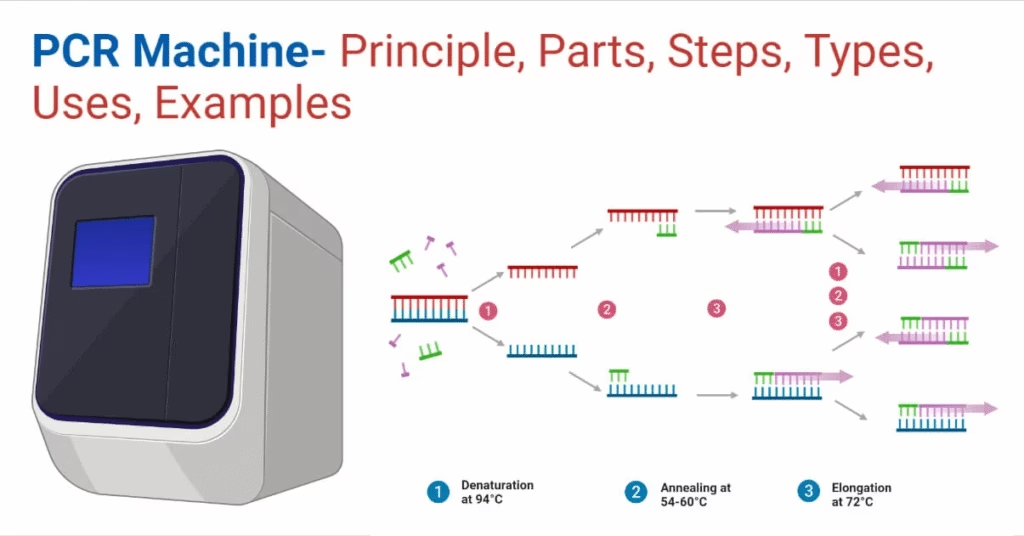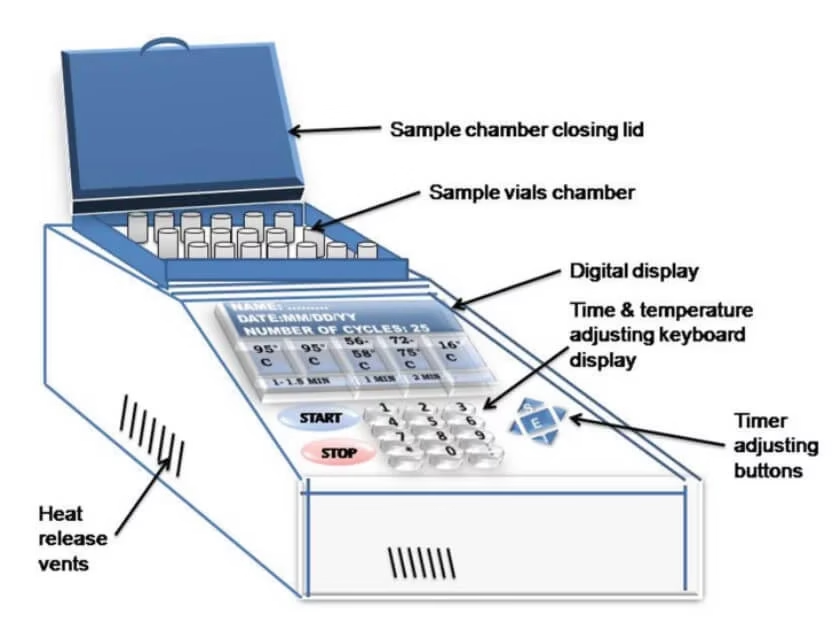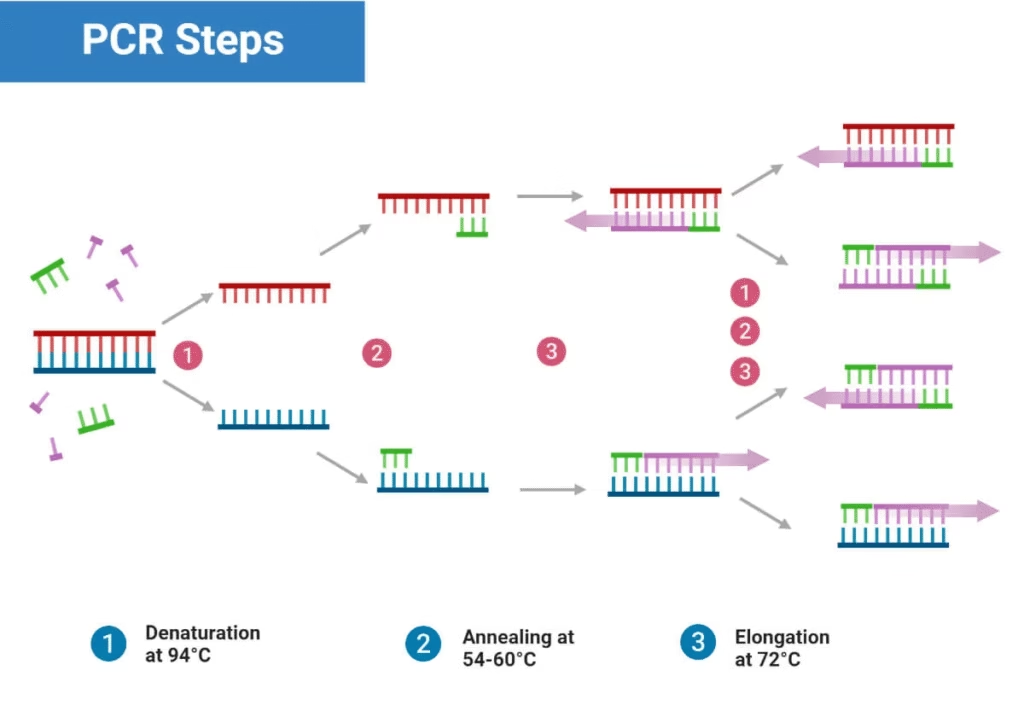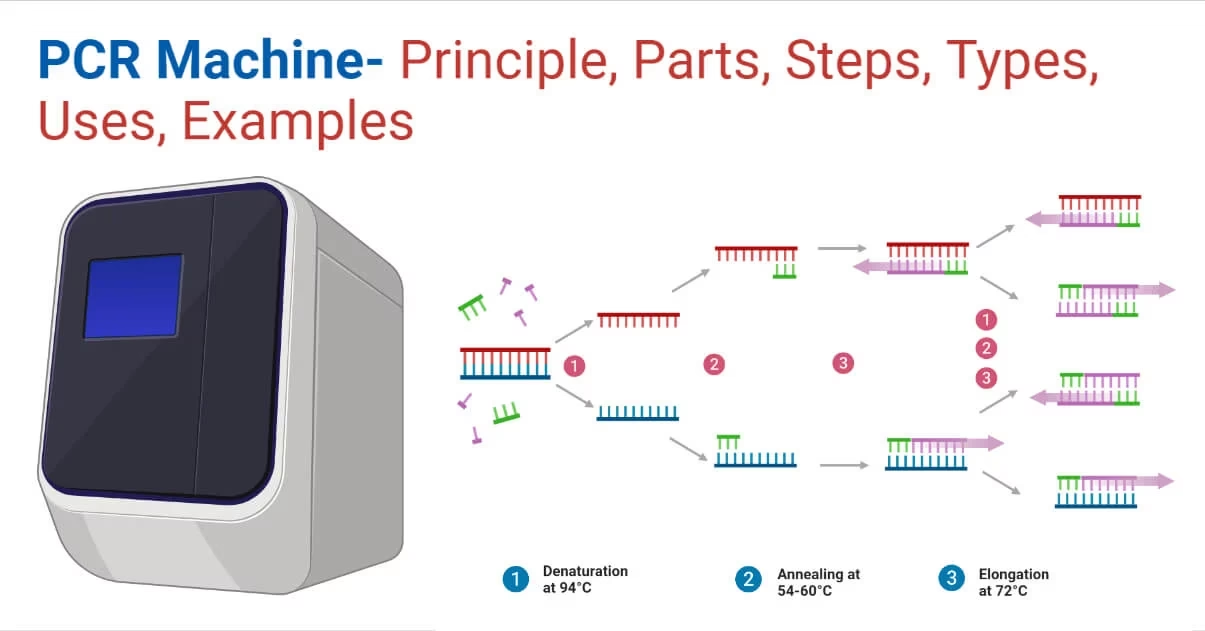Introduction to PCR
The Polymerase Chain Reaction (PCR) is one of the most important techniques in modern molecular biology.
Invented by Kary B. Mullis in 1983, this method allows scientists to create millions of copies of a specific DNA or RNA segment in just a few hours.
For his groundbreaking work, Mullis was awarded the Nobel Prize in Chemistry in 1993.
PCR is sometimes called “molecular photocopying” because it duplicates DNA in the same way a photocopier duplicates documents. This technology has revolutionized research, diagnostics, forensics, and even environmental monitoring.
At the heart of this process is the PCR machine, also known as a Thermal Cycler or DNA Amplifier.

What is a PCR Machine?
- A PCR machine is a laboratory device that amplifies (copies) small segments of DNA or RNA.
- Works based on complementary base pairing and nucleic acid replication.
- Can multiply a target DNA sequence up to 10⁷ times in just a couple of hours.
- Used in:
- Research labs for genetic studies
- Medical diagnostics for detecting infections and genetic disorders
- Forensic science for DNA fingerprinting
- Food safety testing for detecting harmful microbes
Principle of PCR
The PCR process is based on the ability of DNA polymerase enzymes to create a new strand of DNA using an existing strand as a template.
Key points of the principle:
- A single-stranded DNA acts as the template.
- A primer (short piece of DNA) attaches to the template.
- The DNA polymerase enzyme adds nucleotides to build a complementary strand.
- This process is repeated in cycles, producing millions of DNA copies.
By controlling the temperature at specific steps, the PCR machine allows the DNA strands to separate, primers to bind, and new DNA strands to be synthesized.
Main Parts of a PCR Machine

A PCR machine is designed to precisely change temperatures at set intervals for DNA amplification.
Main components include:
- Thermal Block – Holds the reaction tubes and controls temperature changes.
- Heated Lid – Prevents water from condensing on tube caps.
- Control Panel and Display – Lets you set and monitor PCR programs.
- Air Vents – Maintain proper air circulation for temperature stability.
PCR Reaction Components
To run a PCR, you need the following reagents:
- DNA Template
- The DNA or RNA segment you want to copy.
- RNA templates require conversion to DNA in Reverse Transcriptase PCR (RT-PCR).
- Thermostable DNA Polymerase
- Example: Taq polymerase from Thermus aquaticus, which works at high temperatures.
- Primers
- Short DNA or RNA sequences that start the DNA synthesis.
- Bind to specific target regions on the template strand.
- dNTPs (Deoxyribonucleotide Triphosphates)
- Building blocks (A, T, G, C) for making new DNA strands.
- Buffer Solution
- Maintains pH and provides magnesium ions, which are essential for polymerase activity.

Steps of PCR

PCR has three main steps, repeated multiple times:
1. Denaturation (94–96°C)
- High temperature breaks hydrogen bonds between the two DNA strands.
- Result: single-stranded DNA templates ready for copying.
2. Annealing (50–65°C)
- Temperature is lowered to allow primers to bind to complementary sequences.
- Each DNA strand gets a forward and reverse primer.
3. Extension/Elongation (72°C)
- DNA polymerase adds nucleotides to the primers’ 3′ ends.
- New DNA strands are formed.
This cycle repeats 20–40 times, producing millions of identical DNA copies.
Types of PCR
Different variations of PCR are used for different purposes:
- qPCR (Quantitative PCR / Real-Time PCR) – Measures DNA amplification in real time using fluorescent dyes.
- RT-PCR (Reverse Transcriptase PCR) – Converts RNA into DNA before amplification (used for RNA viruses).
- Nested PCR – Improves accuracy by running a second PCR with “nested” primers.
- Hot Start PCR – Prevents unwanted amplification before heating starts.
- Multiplex PCR – Amplifies several DNA targets in one reaction.
- Long-Range PCR – Amplifies large DNA fragments.
- In Situ PCR – Performed inside fixed cells or tissue sections.
Applications of PCR
PCR is a powerful tool with applications in many fields:
- Gene Expression Studies
- Compares gene activity across tissues and conditions.
- Uses reverse transcription to create cDNA from RNA.
- Genotyping
- Detects genetic differences between individuals or organisms.
- Used in breeding programs, disease detection, and genetic research.
- Cloning and Mutagenesis
- Creates genetically modified organisms.
- Introduces mutations for research.
- DNA Sequencing
- Prepares DNA for sequencing in traditional or next-generation sequencing (NGS).
- Medical Diagnostics
- Detects viruses like HIV, Hepatitis B & C, and Human Papillomavirus (HPV).
- Used in prenatal genetic testing and IVF embryo screening.
- Forensic Science
- DNA fingerprinting for criminal investigations and paternity testing.
- Recovers ancient DNA in archaeology.
- Environmental and Food Testing
- Detects harmful bacteria in water, soil, and food products.
Advantages of PCR
- Produces results quickly (within hours).
- Can detect very small amounts of DNA.
- Works for hard-to-culture organisms.
- Allows testing for antibiotic resistance.
Limitations of PCR
- Requires prior knowledge of the target DNA sequence.
- Can introduce errors due to polymerase mistakes.
- Highly sensitive to contamination.
- Efficiency decreases with longer DNA targets.
Precautions for Using a PCR Machine
- Use only PCR-compatible tubes and plates.
- Ensure lids are closed tightly to prevent evaporation.
- Clean any spills immediately.
- Avoid damaging the heated lid.
- Keep the thermal block clean before runs.
- Place tubes evenly for consistent heating.
Examples of PCR Machines
- Biometra TAdvanced Thermal Cycler – Offers high precision and multiple block types.
- MiniAmp™ Plus Thermal Cycler – Compact design with touch-screen controls and WiFi capability.
- Esco PCR Thermal Cyclers – Suitable for various PCR types, including gradient PCR.
- GET-S Series Thermal Cycler (Bio-gener) – Advanced features like WiFi control, touch-screen, and multiple block options.
The PCR machine is a game-changing tool in molecular biology, enabling scientists to quickly and accurately copy DNA for research, diagnostics, and forensic applications. Its versatility and precision have made it a standard piece of equipment in laboratories worldwide.
Whether it’s detecting a virus, solving a crime, or studying genetic mutations, PCR technology continues to be at the forefront of scientific discovery.
References
- Al-Mohanna, Moshtaq & International, Labnet. (2017). Labnet MultiGene Manual. 10.13140/RG.2.2.23499.80164.
- http://escolifesciences.co.th/product-categories/118/
- https://bio-equip.cn/enshow1equip.asp?equipid=97446
- https://www.aatbio.com/resources/faq-frequently-asked-questions/What-are-the-limitations-of-PCR-technology
- https://www.technologynetworks.com/genomics/articles/an-introduction-to-pcr-345445
- https://www.thermofisher.com/order/catalog/product/A37835
- https://zageno.com/l/pcr-reagents
- Jain, A., Jain, R., Jain, S. (2020). Polymerase Chain Reaction. In: Basic Techniques in Biochemistry, Microbiology and Molecular Biology. Springer Protocols Handbooks. Humana, New York, NY. https://doi.org/10.1007/978-1-4939-9861-6_14
- Kadri, K. (2019). Polymerase Chain Reaction (PCR): Principle and Applications. In M. L. Nagpal, O. Boldura, C. Baltă, & S. Enany (Eds.), Synthetic Biology – New Interdisciplinary Science. IntechOpen. https://doi.org/10.5772/intechopen.86491
Other related topics you might be interested in:
Colony Counter – Definition, Principle, Types, Parts, Working, Applications, Advantages & Examples
Ultracentrifuge – Principle, Types, Parts, Working Procedure, Applications, Advantages & Precautions
Micropipette – Definition, Types, Parts, Working, Applications, Errors, Calibration & LimitationsLaboratory Incubator – Principle, Types, Components, Working, Applications, Advantages & Limitations
